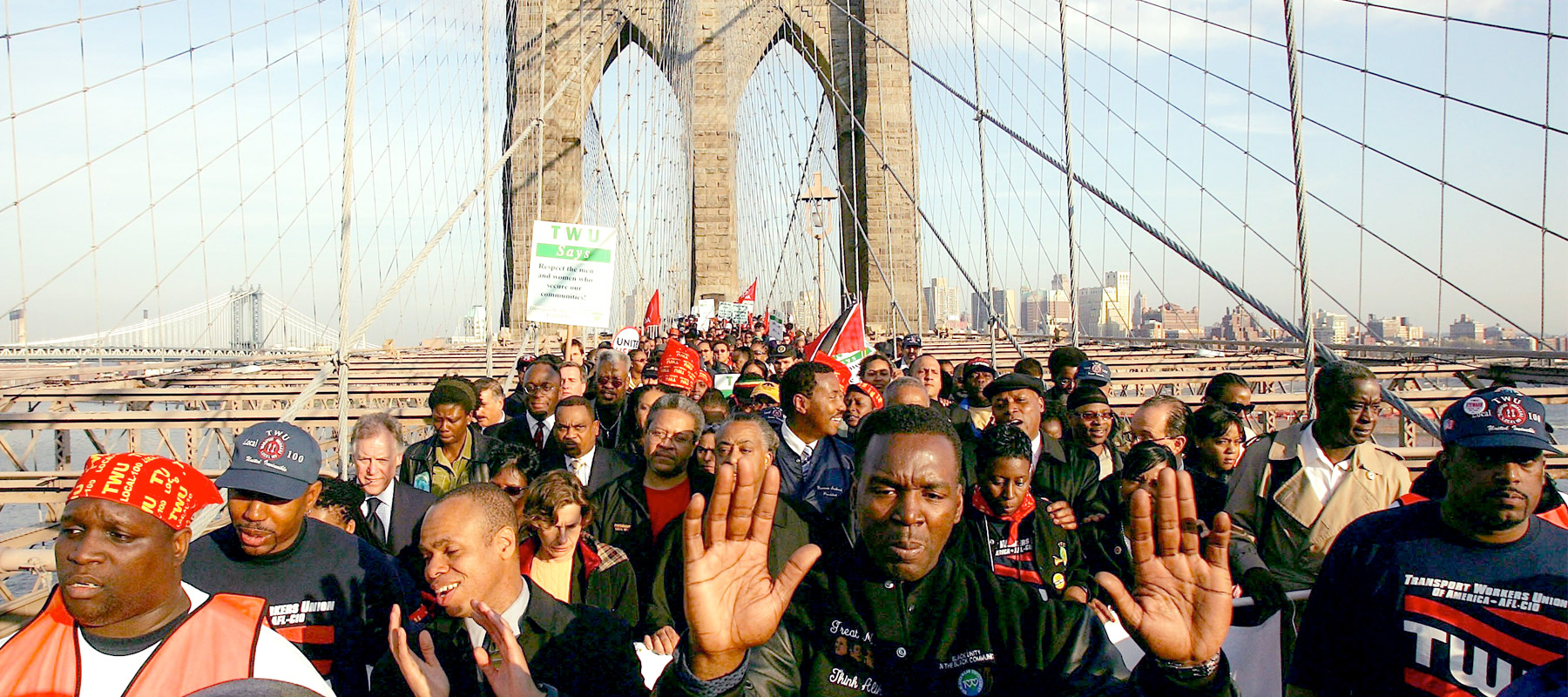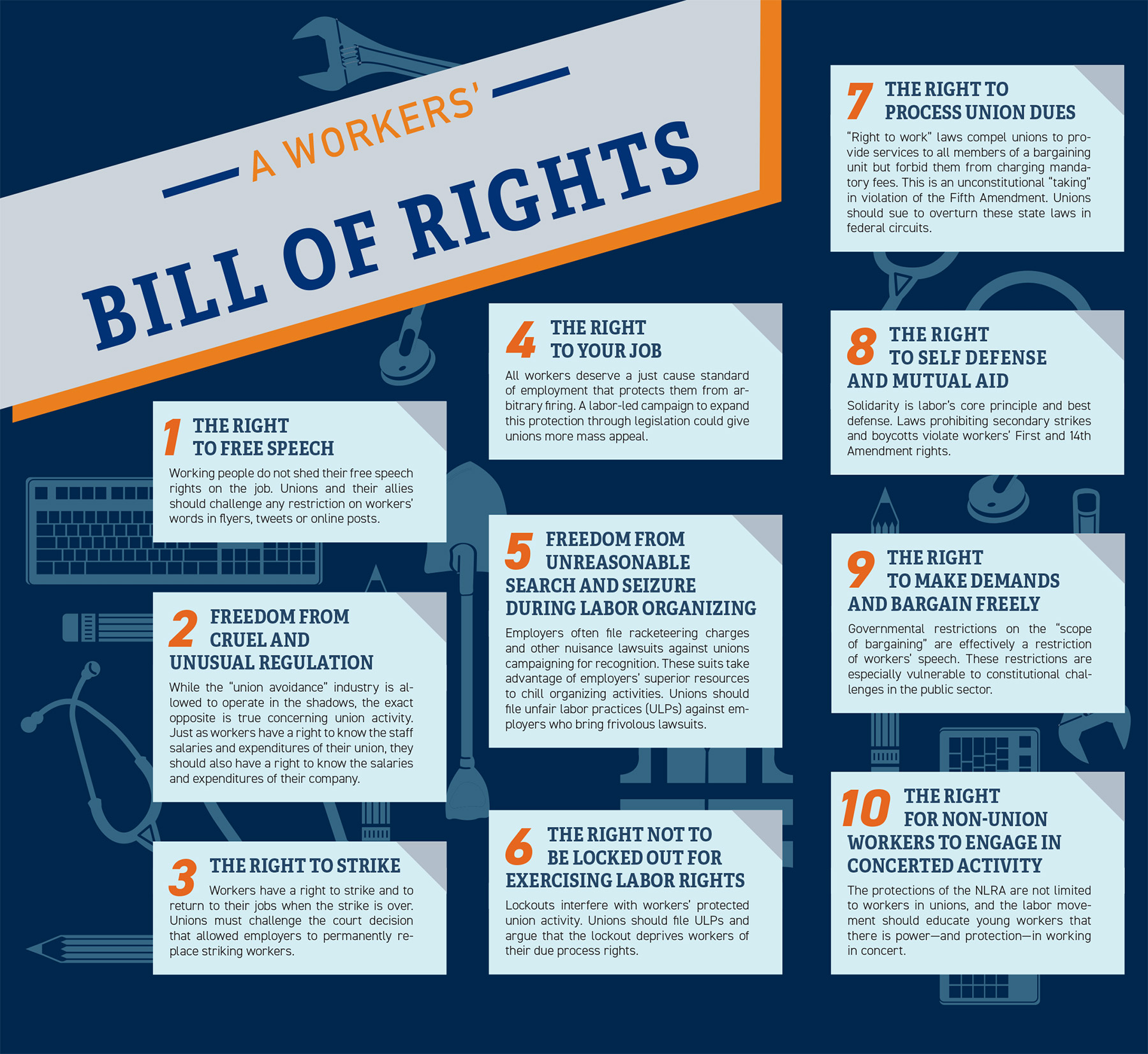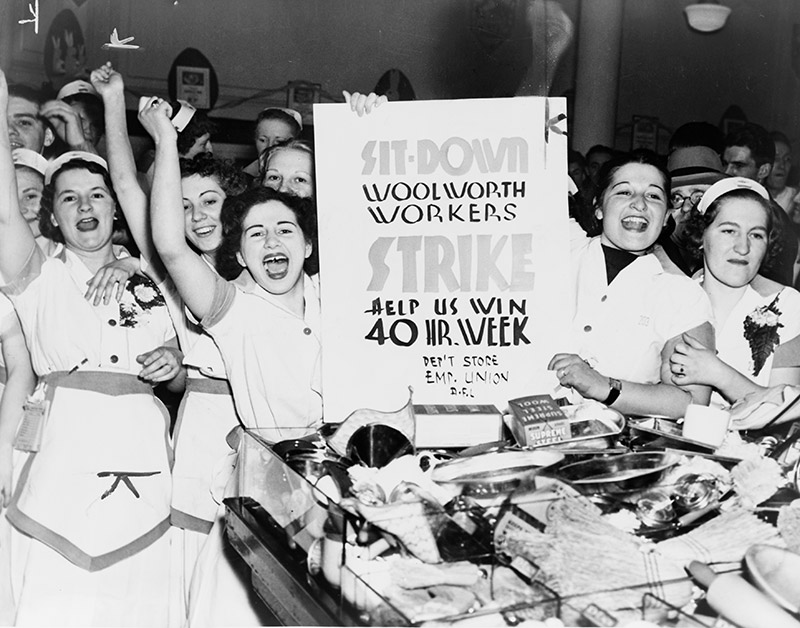
A New Bill of Rights for Workers: 10 Demands the Labor Movement Can Fight for and Win
Now is the time for unions to rewrite the rules
Above: Hundreds of supporters accompany transport union president Roger Toussaint across the Brooklyn Bridge in April 2006. Photo by Spencer Platt/Getty Images.
September 4, 2017 | September Issue
On a cloudy afternoon in April 2006, Roger Toussaint led a procession of union workers across the Brooklyn Bridge. Toussaint, president of Transport Workers Union Local 100 and an immigrant from Trinidad and Tobago, was on his way to surrender himself to the authorities to serve a 10-day jail sentence. His crime? He led the largely Black and Latino union membership in a 60-hour strike the previous winter, shutting down the city’s subway and bus system in violation of a judge’s injunction and New York’s 1967 Taylor Law, which bans public-sector strikes.
The court also slapped the union with a $2.5 million fine and suspended its ability to collect dues for a year. Individual strikers were fined two days’ pay for each day on strike.
Punishments this draconian are rare outside the world of labor law. Toussaint saw more jail time than any of the top bank executives responsible for the 2008 financial crisis.
To change the law—and the barriers to organizing the law poses—we have to change the way we think about it. The sweeping 1935 National Labor Relations Act (NLRA) and the many local laws it spawned are not the source of workers’ rights to organize.
Rather, those rights are rooted in the Constitution through the rights of free speech and equal protection, as well as freedom from involuntary servitude. Labor laws simply regulate those constitutional rights, much as election laws regulate the right to vote. And just as restrictive voter ID laws can violate citizens’ voting rights, bad labor laws can trample workers’ rights. While “corporate persons” have established free speech rights, for example, a union—a collection of actual persons—has no similarly recognized protections. This disparity would in turn seem to violate the 14th Amendment right to equal protection under the law.
Unions must reverse a half-century-long strategy of avoiding the courts and mount legal and political challenges to labor laws that infringe on workers’ speech, curtail their bargaining power and deny them the right to extend solidarity to fellow workers. This is a long-term strategy, one made longer-term by the inability to appoint progressive federal judges in the near future. But if we are ever to restore key protections for labor, we need to demand a workers’ bill of rights.
In a July report for The Century Foundation, I propose 10 such rights as well as strategies to advance them that can be adopted by both union officials and rank-and-file workers.


The first recorded court case involving worker organizing in the United States dates back to Thomas Jefferson’s second term. Shoemakers picketing for higher wages were convicted of using “threats, menaces and other unlawful means” to maintain a conspiracy.
That set the tone for jurisprudence of workers’ rights in the new republic, where conservative jurists treated union organizing as a criminal activity. As a result, unions spent the 19th and early 20th centuries decrying “judge-made law” and demanding the codification of their rights.
These demands resulted in a landmark victory. The 1935 NLRA encouraged collective bargaining by establishing a federal agency, the National Labor Relations Board (NLRB), to certify the existence of a union at a workplace and sanction employers who refused to deal with a bona fide union.
Another point of the NLRA was to keep labor disputes out of the courts. Most unions have stuck with the intent of the Act and shied away from pursuing rights and benefits that cannot be won at the bargaining table. Employers have shown no such reticence. They’ve attacked workers’ rights in the courts since the day the NLRA was passed, steadily chipping away at hard-won protections.
A fundamental flaw in the Act opened the door to these successful attacks. The NLRA’s authority derives from the Constitution’s commerce clause. Legal experts at the time argued that this framing had the best shot at withstanding legal challenges under a Supreme Court hostile to New Deal legislation.
Representatives of the American Federation of Labor (AFL) had, instead, pushed hard to base the Act on the 13th Amendment, which banned slavery and involuntary servitude. The AFL’s Andrew Furuseth warned of settling for short-term legislative gains while leaving unsettled the legal question of “whether or not that man or woman shall have a right to combine with others for the purpose of ... doing collectively what you can’t do individually.”
His concern proved prescient. The NLRA’s grounding in the commerce clause means that when labor disputes go to court, they are judged by their potential impact on business. The last half-century has demonstrated that, by this yardstick, the courts consistently sympathize with business interests. As a result, unions are hampered by rules that would never be applied to corporations, or to any other form of political action.
Consider what happens when workers decide to form a union. The rules of union certification elections, set by a series of unfortunate court cases and NLRB decisions, permit employers to force workers to attend “vote no” presentations or be fired.
In a 2009 study, Cornell University’s Kate Bronfenbrenner found that employers utilized these captive audience meetings in nine out of 10 union elections. Employers threatened to cut wages and benefits in 47 percent of documented cases, and to go out of business entirely in 57 percent of cases. In one in 10 instances, bosses actually hired goons to impersonate federal agents and lie about the process. Not surprisingly, unions lose 57 percent of elections when employers run these “captive audience” meetings.
Ironically, corporations have argued for—and won—the right to hold these meetings on the grounds of their First Amendment rights as “persons.” Yet union advocates possess no equivalent right to hold their own “vote yes” meetings.
The captive audience meeting is but one of many areas in which labor law favors employers. Workers form unions because they want a say on the job. Yet employer-friendly court decisions have created a distinction between “mandatory” and “permissive” bargaining issues. Employers are required to bargain over the former, but can legally tell the union to go to hell when it raises the latter. Labor law thus removes from the bargaining table many of the issues that matter most to workers, including the decision to downsize, subcontract or shift work overseas.
The existing labor law regime even circumscribes solidarity, the lifeblood of unions. “An injury to one is the concern of all” is one of the oldest precepts of the labor movement, yet it is illegal for unions and workers to officially join others’ strikes and boycotts.
Corporations, by contrast, engage in so-called secondary boycotts all the time. Cable providers, for example, black out television channels to protest a network’s rate increase, instructing viewers to call the network CEO to complain. Why are secondary boycotts legal when used by media companies for profit, but illegal when exercised in solidarity by workers?

DETROIT, 1937—Sit-down strikes were once one of labor’s greatest strategic weapons. Sales clerks at a Woolworths department store staged a sit-down strike, demanding raises, overtime pay, an 8-hour work day, a union hiring hall and no retaliation against the strikers. After the all-female group occupied the store for seven days, management conceded. In 1939, the Supreme Court ruled that employers had the right to fire sit-down strikers, even if they were protesting a labor violation. This made the tactic unbearably risky, and it has all but disappeared from labor’s arsenal.
Unions have been playing defense for so long, they tend to accept the rigged rules. But a fresh look at the body of labor law reveals many restrictions on union activity to be constitutionally suspect.
There are several arenas where unions can advance a rights-based agenda. First, they can push the NLRB for rule changes. A group of leading labor scholars is currently petitioning the NLRB to re-establish a rule guaranteeing equal time for pro- and anti-union presentations in the workplace. Trump’s Republican-dominated NLRB won’t be sympathetic. The next Democratic NLRB should be keenly aware of what a limited window for action it may have.
In some cases, unions must be prepared to defy NLRB orders and push key questions into the courts. Labor groups might start by challenging the excessive restrictions on signal picketing (efforts to embarrass unfair employers without an explicit call for a boycott). Noxious hate groups such as the Ku Klux Klan and the Westboro Baptist Church have seen their pickets vigorously defended by the courts. Unions should argue that to restrict signal picketing is to violate workers’ First and 14th Amendment rights.
Of course, labor can’t rely on the courts and the federal government to save it. Advancing a workers’ bill of rights will also require protest and direct action, but this must be complemented by new legal and political strategies. Whenever public-sector unions defy state-level no-strike laws, as the New York City transit workers did in 2006, they should seek federal injunctions to stop the state from issuing crippling punishments, arguing for their right to strike on First and 13th Amendment grounds.
In all of these arenas, labor must be willing to make bold demands. The NLRA was drafted and passed within a matter of months, in part because it reflected the rights-based agenda that labor advanced for decades.
It is time for unions to return to demanding workers’ rights without apology. 
is an In These Times contributing writer and a campaign consultant with 15 years experience as a union organizing director and representative.
Want more independent news and analysis? Subscribe to the free In These Times weekly newsletter:
